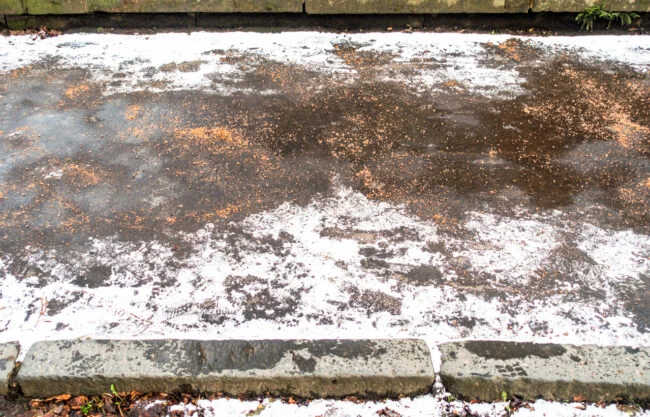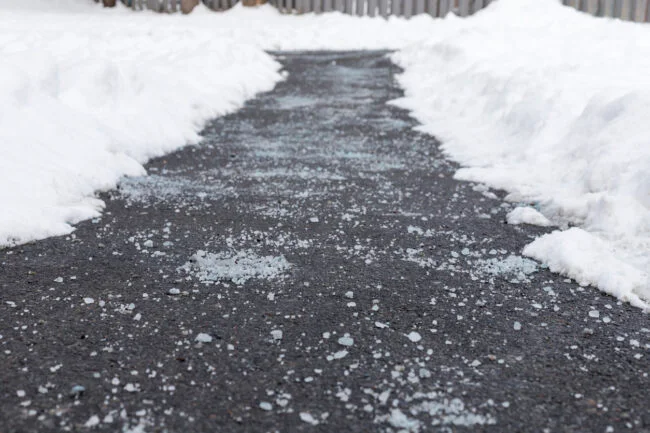When winter storms hit and rock salt is in short supply, finding effective and environmentally friendly alternatives becomes crucial. Melting ice without salt or traditional ice melt products is not only possible but also beneficial for your property, pets, and the environment. In this guide, we’ll explore six innovative ways to keep your driveway, walkway, and porch ice-free without relying on rock salt.
Snow Melting Mats:

Investing in snow melting mats provides a passive and convenient solution. These mats, when laid along high-traffic areas, generate heat that efficiently melts ice and snow without the need for shoveling. While the initial cost may be higher, the long-term benefits make them a worthwhile investment.
Fertilizer:
Consider using fertilizer as an alternative to rock salt. Opt for a high-nitrogen fertilizer such as ammonium sulfate, potassium chloride, or urea. Though not as fast-acting as rock salt, these nitrogen-rich fertilizers effectively lower the melting point of ice without causing damage to pavement or the environment.
Coffee Grounds:

Don’t discard used coffee grounds – they can be an excellent organic solution for melting ice. Coffee grounds contain nitrogen, which lowers the ice’s melting point. Additionally, their dark color absorbs sunlight, aiding in the melting process.
Rubbing Alcohol Solution:
Create a cost-effective homemade ice melt solution using isopropyl alcohol. Mix a 16-ounce bottle of alcohol with 1 teaspoon of concentrated dish soap and 4 gallons of hot water. This solution efficiently clears ice, but be sure to shovel away excess water to prevent refreezing.
Sugar Beet Juice:
Surprisingly effective, sugar beet juice, available in liquid or powdered form, can lower the melting point of ice and snow. Safe for concrete, asphalt, plants, cars, and pets, sugar beet juice is an unconventional yet eco-friendly option.
Vinegar Solution:
Utilize the acetic acid in vinegar to lower the melting point of ice. While not as potent as rock salt, a mixture of equal parts vinegar and hot water can effectively melt ice, allowing for easy removal with shoveling.
When Chloride Compounds Are Necessary: If eco-friendly alternatives aren’t viable, some chloride compounds are less harmful than others. Calcium chloride is a widely used non-sodium ice melt with effectiveness down to -25°F. Magnesium chloride is pet-safe but may cause stomach upset. Sodium chloride (rock salt) is affordable but less environmentally friendly. Potassium chloride works more slowly but is a viable option. Consider these choices based on your specific needs and environmental concerns.
Closing Thoughts on Chloride Compounds for Ice Melting:

When all else fails, and traditional “ice melt” products become your last resort for clearing snow from your hardscaping, it’s essential to understand the potential environmental impacts associated with chloride compounds. While these products are effective, they can harm waterways, corrode surfaces, and pose risks to lawns and plants when applied excessively.
Here’s a breakdown of commonly used chloride compounds:
- Calcium Chloride:
- Widely employed as a non-sodium ice melt.
- Melts ice at temperatures as low as -25°F.
- Considered more environmentally friendly than some alternatives.
- Magnesium Chloride:
- Often promoted as safer for pets, but the ASPCA notes potential stomach upset.
- Effective down to 0°F.
- Offers a compromise between effectiveness and safety.
- Sodium Chloride (Rock Salt):
- Commonly used due to affordability.
- Effective down to +20°F.
- Prone to causing environmental damage and corrosion.
- Potassium Chloride:
- Once used occasionally.
- Melts ice more slowly than other chlorides.
- Effective down to +25°F.
If speed is crucial but you’re willing to prioritize environmental friendliness, calcium chloride stands out. It works efficiently between 0 and 30 degrees Fahrenheit and is readily available in many home improvement stores. Both potassium chloride and magnesium chloride also serve as eco-friendly options, with magnesium chloride being particularly safe at temperatures as low as -13°F.
In emergencies where choices are limited, it’s advisable to weigh the pros and cons of each compound based on your specific needs. Consider factors such as whether you’re parking a car on the treated surface or if there are children and pets at risk of coming into contact with the ice melt. Making an informed decision ensures that you not only tackle the immediate issue but also do so in a manner that aligns with your environmental concerns and overall well-being.
Conclusion:
While traditional ice melt products containing chloride compounds may be readily available, exploring eco-friendly alternatives ensures a safer and more sustainable approach to keeping your outdoor spaces ice-free. From snow melting mats to coffee grounds and vinegar solutions, these methods not only protect your property but also contribute to a healthier environment. Choose the option that best aligns with your needs and values for a winter without the environmental drawbacks of rock salt.
image source : istockphoto










